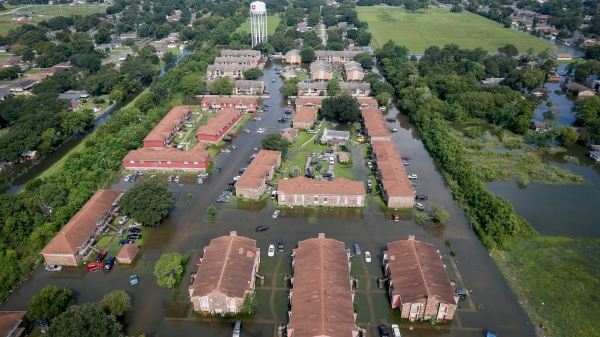ASU preservation facility serves as test bed for rooftop heat mitigation

Arizona State University spinout EnKoat co-founder Matthew Aguayo (left) assists SRP Engineering Manager Peter Hamstra with installation of a temperature and humidity tower outside the High Density Collections facility on the Polytechnic campus. The building has three bays regulated at 50 degrees and 30% humidity for archival storage. Probes inside the building will measure heat differences between roofing areas with EnKoat’s “IntelliKoat” coatings and those without. Photo courtesy of Matthew Aguayo
A roof coating that uses thermal energy storage materials from Arizona State University spinout EnKoat is halting the heat in several ASU buildings — including a section of the university’s largest preservation facility. The company is collaborating with ASU and the Salt River Project (SRP), a nonprofit that provides water and power to residents in central Arizona.
Heat mitigation is a growing requirement for buildings and road surfaces in the desert Southwest, but that control is especially critical for the facility's High Density Collections (HDC), a 40,000-square-foot repository for 2.5 million books, scholarly journals and other historic materials stored at the Polytechnic campus. The contents of the building are kept at 50 degrees F and 30% humidity all year long.
The collaboration is for a two-year study using sensors to track the temperatures and energy costs in two of three sections of the HDC — one with the company’s proprietary coating system, IntelliKoat, and one without.
“SRP will compare internal building temperatures of the section coated with IntelliKoat to the section that has not been coated,” said EnKoat co-founder Aashay Arora. “This will help them calculate energy efficiency improvement with (the) IntelliKoat system, especially at times when there is peak demand in the grid.”
Co-founder Matthew Aguayo said, “It also will potentially provide custom rebate solutions for SRP customers and serve as a tool to educate the industry as a whole as to how these new technologies are able to both improve energy efficiency and reduce load demand on the power grid.”
Thermal energy storage (TES) materials can keep the heat out of vital spaces by transforming from solid to liquid and back again to store and release heat. For IntelliKoat, these TES materials are dispersed inside a coating, which is applied as a seamless, monolithic layer across the entire roof surface.
“Think of an ice pack in an ice chest,” explained Aguayo. “The ice pack melts but can still keep the drinks in the ice chest at a certain temperature. Then you take that ice pack and refreeze it again.
“Now, envision that ice pack as a particle about half the diameter of a hair, and you can put that into any coating product, in this case our IntelliKoat system. It’s not going to freeze at 32 degrees, it’s going to freeze and melt at the application-specific temperatures we design it for. In Arizona, we design it for a hot climate. In colder climates, we design it accordingly.
“With IntelliKoat, as the temperature rises during the day, the particles change from solid to liquid. As it cools, they solidify again. In the coating, these TES materials are encapsulated, like the ice in the ice pack. They aren’t released into the environment and are able to maintain their performance for over 10,000 heating and cooling cycles."
EnKoat’s encapsulation process is known as ActivTherm.
Moreover, the materials used in EnKoat products are made with bio-based renewable feedstocks and contain very little to no volatile organic compounds (VOCs), which means that they will not release toxic vapors upon application or over time.
EnKoat was founded while Aguayo and Arora were doctoral students in ASU’s School of Sustainable Engineering and the Built Environment (SSEBE).
“Originally, the team started looking for new ways to prevent thermal cracking in concretes,” according to SSEBE Professor Narayanan Neithalath, the students’ advisor.
“When that was successful, we wondered if using the same technology could keep buildings cooler,” Neithalath said. He was able to secure research funding for the duo to “investigate if embedding TES materials into paint, plaster and stucco — three of the most common coatings for buildings — could maintain comfortable interior temperatures for houses and other structures.”
Their research was successful, and EnKoat was born.
While major corporations had already looked at using TES materials for building products, “it was a different application,” explained Neithalath. “They were using the technology to make gypsum board, not coating rooftops. Builders weren’t going to spend $70 instead of $12 per piece of gypsum board for drywall.”
Aguayo and Arora initially installed the roof coating on the Agribusiness Center at the Polytechnic campus while they were doctoral students. Internal thermostats on both coated and uncoated portions of the building have been providing comparative monitoring for five years. While energy use was not tracked for that project, the results were impressive enough to bring SRP into the next phase of testing.
Currently, EnKoat is focused on coatings for flat and low-slope roofs, but they are investigating the development of a spray-on product for vertical surfaces. “This would be for a prefab wall inside a factory,” Arora said.
One recent application was for a chilled drinking fountain for the city of Phoenix. IntelliKoat was applied on one of two fountains as a test for future cooling fountain treatments. According to the city, the treatment did lower the temperature.
Arora and Aguayo have an ongoing research partnership and funding for which they are using ASU facilities. “They have grants from federal agencies, collaborations with industrial partners and a contract with a company that is manufacturing the coatings at scale,” Neithalath said.
Ultimately, the team hopes to create partnerships with manufacturers, distributors, contractors and building owners throughout the country. Being able to provide utility service providers and energy companies with a cost-effective and scalable solution to manage peak demands on the power grid is especially important given the increased demand from electric vehicles and AI technologies.
"Our IntelliKoat system allows us to create next-generation solutions to decarbonize the built environment not only here in the Southwest but globally,” Aguayo said.
More Environment and sustainability

NSF-funded, ASU-led research network tackles flood justice
Like many environmental risks, flooding exacerbates preexisting social inequalities, with marginalized communities often bearing the brunt of its impact.In a groundbreaking effort to address those…

Walton sustainability program empowers K–12 educators to combat food waste
Food waste is one of the most pressing issues of our time, affecting the environment and economies worldwide. According to the U.S. Environmental Protection Agency, the significant greenhouse…

8 ways to protect wildlife
Editor's note: This is the sixth story in a series exploring how ASU is changing the way the world solves problems.On a cool morning, you hike a desert trail, noticing the life around you.…




